Salamanca, Spain
Salamancais a vibrant city located in the northwestern region of España(Spain). It is rich with historia(history), arquitectura(architecture), and una animada escena cultural(a lively cultural scene). Read on for some highlights that you might want to include in your itinerary when visiting Salamanca!
Questions This Article Answers
What should I visit in Salamanca?
What should I do in Salamanca?
What are the landmarks in the Old City of Salamanca?
Where is the famous astronaut in Salamanca?
Where can I see the frog in Salamanca?
Old City of Salamanca
The Ciudad Vieja de Salamanca(Old City of Salamanca) or casco antiguo(old town or historic center) is filled with stunning examples of Romanesque, Gothic, Moorish, Renaissance, and Baroque architecture. It has been declared a Patrimonio de la Humanidad(World Heritage Site) by UNESCO.
The Old City of Salamanca contains a number of important landmarks, such as the Universidad de Salamanca(University of Salamanca), the Plaza Mayor(Main Square), the Casa de las Conchas(House of the Shells), the two catedrales(cathedrals), the Convento de San Esteban(San Esteban Convent), the Puente Romano(Roman Bridge), the Casa Lis(Lis House), the Iglesia de la Clerecia(Clerecia Church), the Palacio de Monterrey(Monterrey Palace) and the Torre del Clavero(Guard Tower). Let's learn a bit more about each of these must-see Salamancan landmarks!
La Universidad de Salamanca
The Universidad de Salamanca (University of Salamanca), founded in 1134, is one of the oldest universities in Europe. Renowned for its stunning architectural beauty and rich history, the institution has played a significant role in the evolution of the Spanish language. Over the centuries, it has attracted scholars from around the world, and is currently a prestigious center of higher education known especially for its programs in humanities and law.

La fachada de la Universidad de Salamanca(the facade of the University of Salamanca), shown in the photo above, is a masterpiece of estilo plateresco(Plateresque style) and is adorned with intricate carved motifs. If you visit, be sure to look for the hidden rana(frog), which is said to bring good luck to the lucky students who spot it.
La Plaza Mayor
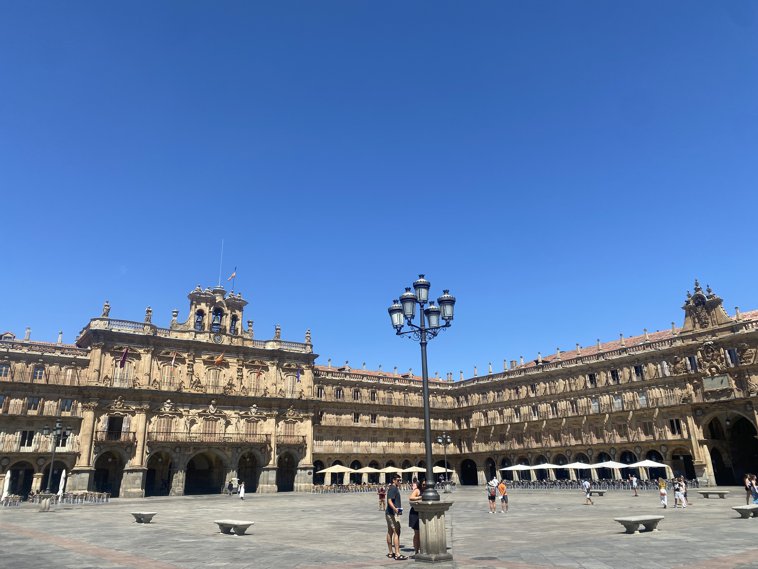
The Plaza Mayor (Main Square) is a grand Baroque square renowned for its harmonious design and uniform sandstone architecture. Constructed in the 18th century, it features arcades lined with cafes, shops, and traditional establishments. As the heartbeat of Salamanca, the square hosts various events, festivals, and gatherings, with its buildings bearing medallones(medallions) of historical figures important to the region.
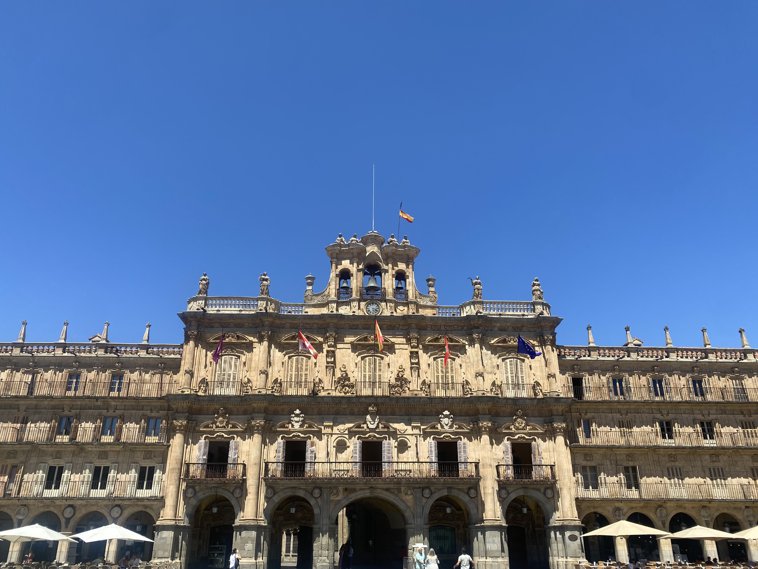
If you visit Salamanca or live there for any period of time, you will likely find yourself meeting a friend under el reloj de la plaza(the square's clock), featured in the picture above, to go out to tapear(to go out for tapas).
La Casa de las Conchas
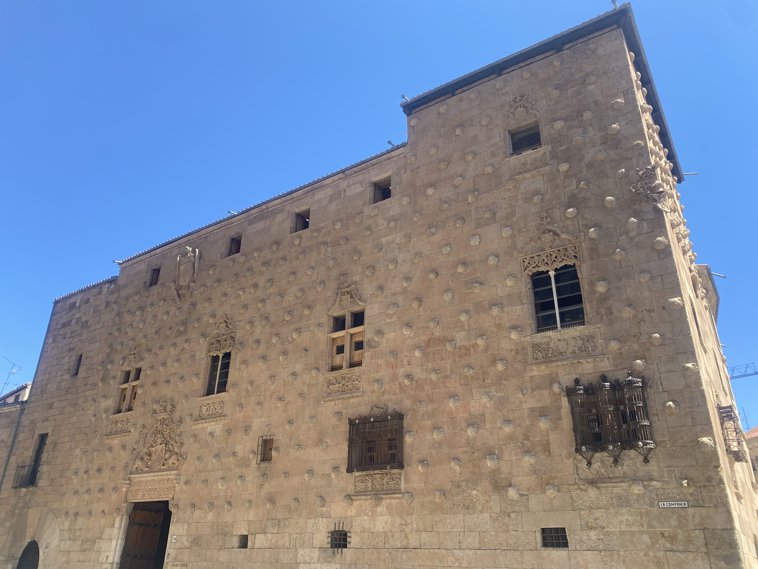 The Casa de las Conchas (House of Shells) is a historic building known for its Gothic and Renaissance architectural styles. It's decorated with over 300 carved stone shells, symbolizing la Orden de Santiago(the Order of Santiago) . Constructed in the late 15th and early 16th centuries, this unique structure originally served as a residence for Rodrigo Maldonado, a knight of the Order of Santiago. Today, it houses a biblioteca pública(public library) and attracts visitors due to its intricate facade and association with romantic legends.
The Casa de las Conchas (House of Shells) is a historic building known for its Gothic and Renaissance architectural styles. It's decorated with over 300 carved stone shells, symbolizing la Orden de Santiago(the Order of Santiago) . Constructed in the late 15th and early 16th centuries, this unique structure originally served as a residence for Rodrigo Maldonado, a knight of the Order of Santiago. Today, it houses a biblioteca pública(public library) and attracts visitors due to its intricate facade and association with romantic legends.
The Two Cathedrals
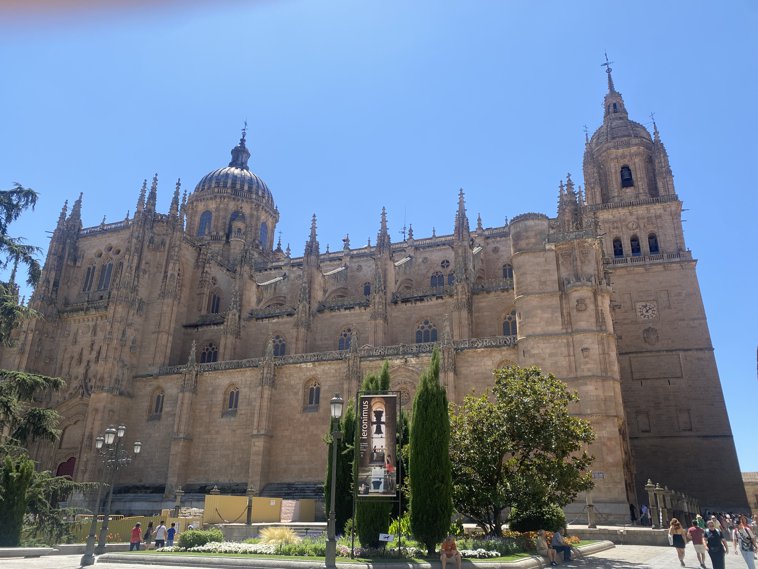
Salamanca boasts not one, but two cathedrals, la Catedral Vieja(the Old Cathedral) and la Catedral Nueva(the New Cathedral). The Old Cathedral, built in the 12th century, is a great example of Romanesque architectural style and features a fresco-covered apse known as la Torre del Gallo(the Rooster Tower). In contrast, the New Cathedral, which was constructed between the 16th and 18th centuries, is a great example of Gothic and Baroque architecture style.
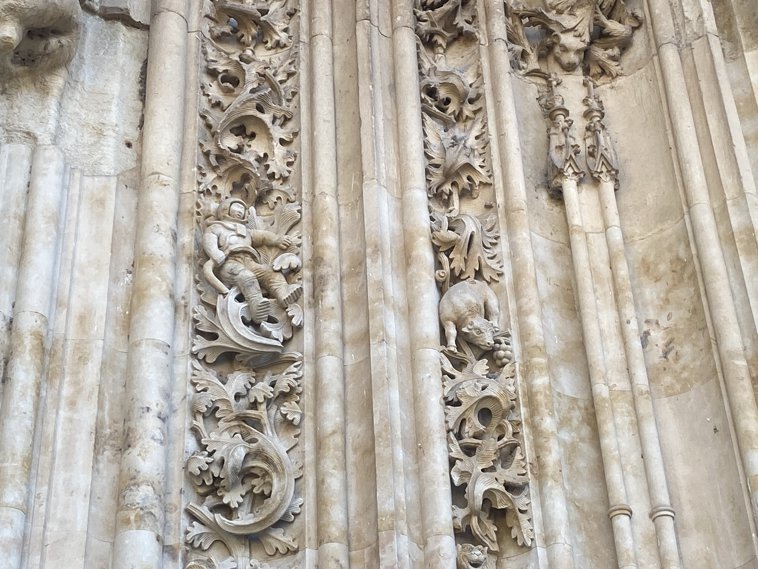
Alongside more traditional carvings, the New Cathedral is known for being the home of el astronauta moderno(the modern astronaut).
During a restauración(restoration) of the cathedral in 1992, stonemasons were given the liberty to incorporate contemporary motifs alongside traditional ones. As a result, an astronaut was carved into the stone of the magnificent centuries-old facade.
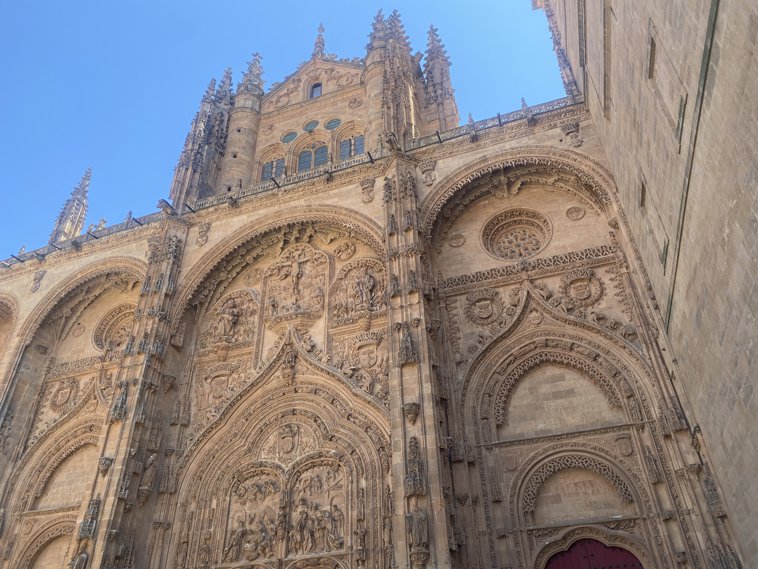
In the photo above, you can admire the detailed carvings of the New Cathedral.
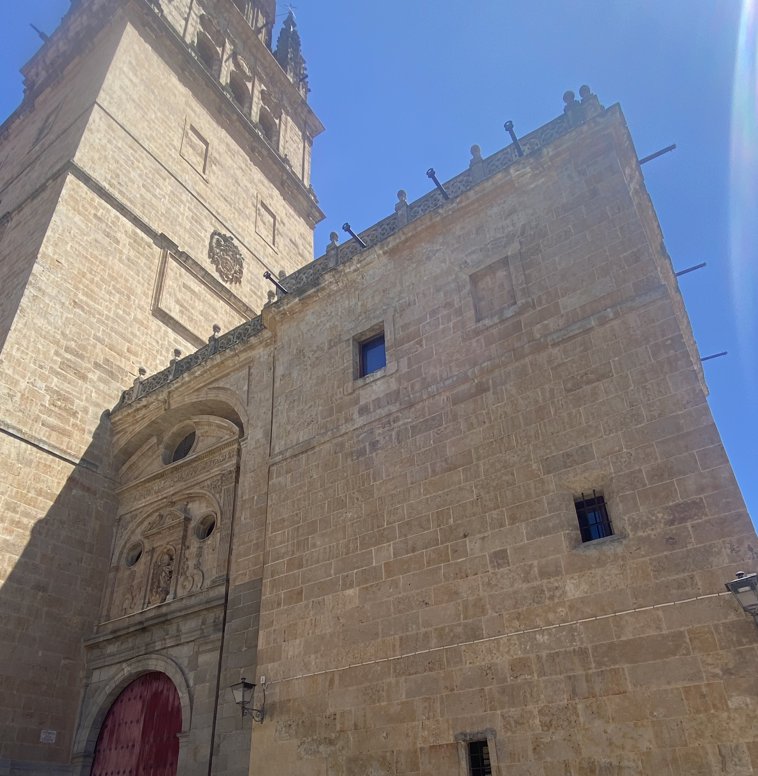
In the photo above, you can see the Romanesque architecture of the Old Cathedral.
Convento de San Esteban
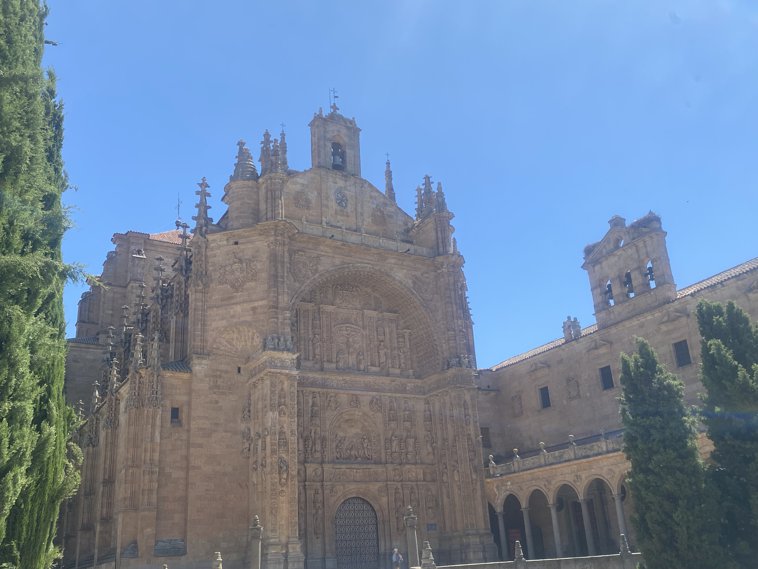
The Convento de San Esteban (San Esteban Convent) is a striking Dominican convent renowned for its stunning Plateresque facade and rich history. Due to its monumental nature, many tourists think they're looking at another cathedral when they stumble upon it. Built between the 16th and 17th centuries, this architectural masterpiece boasts a carved entrance, an imposing church, and a claustro (cloister) known for its mix of Gothic and Renaissance styles. Historically, it has been a center of theological study and is associated with famed scholars like Francisco de Vitoria. Visitors are often captivated by its choir stalls, the sacristy, and the ornate retablos(altarpieces), making it one of Salamanca's must-see landmarks.
Puente Romano
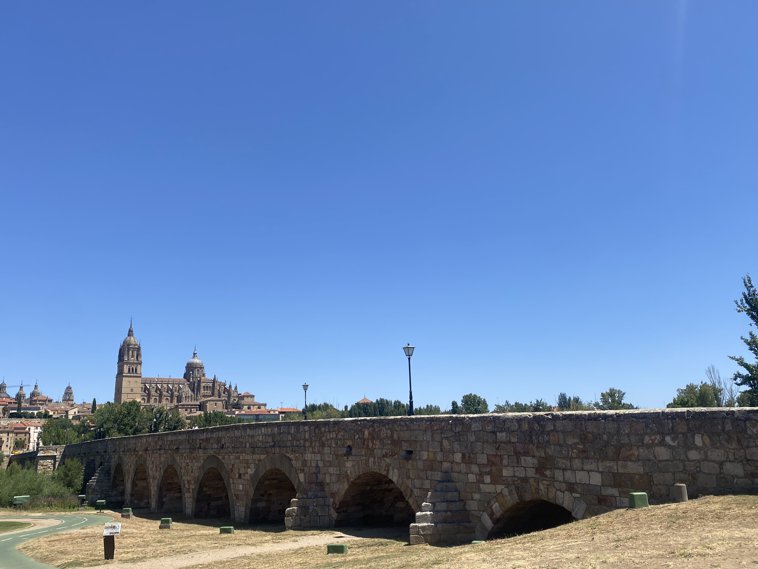
The Puente Romano(Roman Bridge) is an ancient stone bridge that spans the río Tormes(Tormes River). Dating back to the 1st century AD, this enduring structure is one of the city's most iconic landmarks. Originally built during Roman times, the bridge consists of 26 arcos(arches), though it originally had 27. Over the centuries, it has witnessed countless events and has remained largely intact, serving as a testament to Roman engineering prowess. Today, it offers a pedestrian-friendly pathway and provides stunning views of the city, especially at sunset.
The Casa Lis
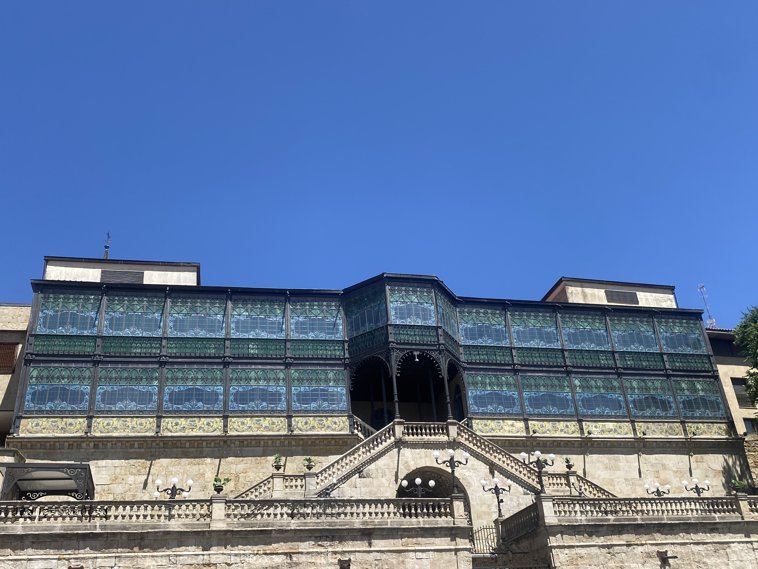
The Casa Lis(Lis House) is an Art Nouveau and Art Deco museum housed in a stunning Modernist building dating back to the early 20th century. Designed by Joaquín de Vargas, the structure is distinguished by its beautiful fachadas con vidrieras(stained-glass facades) and ironwork. Within its walls, the museum showcases an impressive collection of artes decorativas(decorative arts) from the 19th and 20th centuries, including porcelana(porcelain), esmalte(enamel), cristal(glass), and juguetes(toys). Beyond its artistic treasures, the Casa Lis offers vistas panorámicas(panoramic views) of the old city and the Tormes River, making it a beloved cultural and architectural gem of Salamanca.
The Clerecía Church
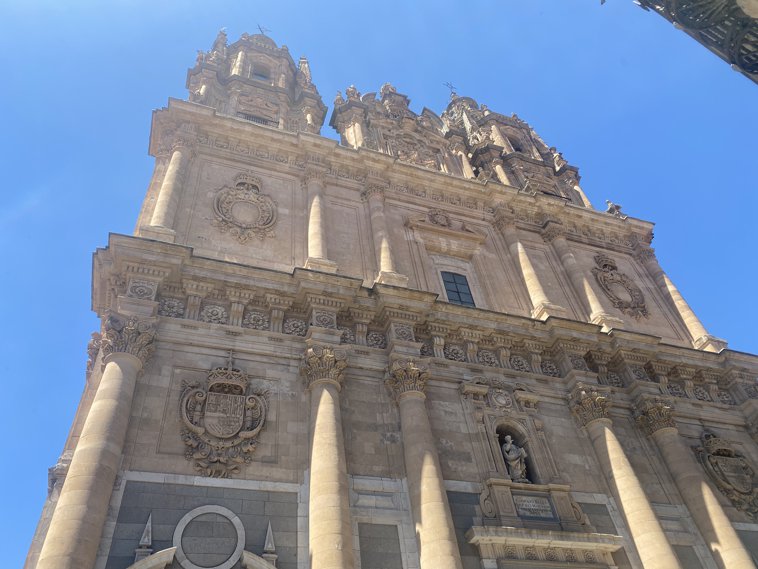
The Iglesia de la Clerecía(Clerecia Church) is a monumental Baroque edifice built between the 17th and 18th centuries. Originally constructed as the Royal College of the Society of Jesus, it features a grand facade with three ornate towers. One of the highlights of the church is the Scala Coeli, a set of towers that visitors can walk up to see panoramic views of Salamanca.
The Palacio de Monterrey
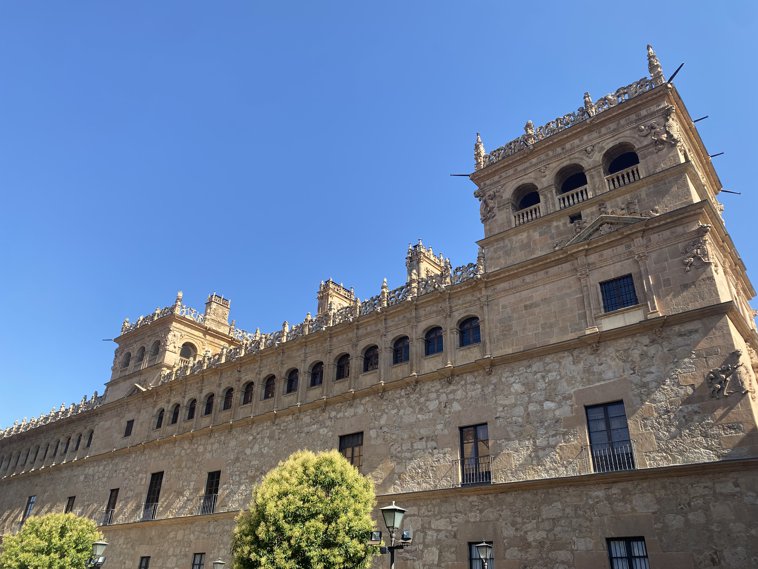
The Palacio de Monterrey(Monterrey Palace) is a prominent Renaissance-style palace built in the 16th century. Commissioned by the conde de Monterrey(Count of Monterrey), it stands as a prime example of the Plateresque architectural style. The palace features four corner towers, a central courtyard, and sculpted motifs that highlight its noble heritage. Though originally intended to be a vast complex, only one of its wings was completed. Today, the Palacio de Monterrey remains one of Salamanca's most distinguished landmarks and houses the House of Alba art collection.
Vocabulary: Salamanca
Yearning to visit Salamanca and gaze upon its architectural treasures? Get ready by familiarizing yourself with our list of essential vocabulary for anybody visiting Salamanca, Spain!
Visiting Salamanca, Spain
Here's a conversation between two friends who are visiting Salamanca for the first time:
Want to learn more about Spain? Check out the following articles!














